Since the arrival of social media and networks we’ve been covering the importance of social customer service and, along with it, social CRM. In most organizations offering service via social media has been rather isolated from overall customer service in the early days, even if quite some contact centers supported social channels very early on.
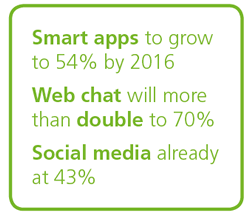
Today that picture is clearly changing. Although some social care experts argue that social customer service is ‘something different’ and shouldn’t necessarily happen within the contact center or customer care department, things are changing fast, obviously depending upon the context of your organization, activities and customers.
We can’t keep arguing that servicing customers via Twitter and the likes is something that requires a dedicated team because it requires special skills. These skills can be assigned to any department whatsoever. We also can’t keep saying that social customer service must belong to a ‘social team’ because it’s also about reputation management, sentiment etc.
The market is clearly moving in the direction of a consolidation of social care, contact center solutions and even customer experience management platforms as some recent acquisitions have shown.
Evolutions driving social care in an overall customer service context
And it makes sense for many reasons, mainly for service-intensive organizations. Here are just a few.
The customer is one
When we keep treating social care separately for historical reasons we think from our own perspective and how we are organized. We don’t think from the customer perspective. By now it should be clear that customers expect first contact resolution and most of all consistency and seamless service regardless of the channel. This requires a strong connection between social customer service and overall service operations. It’s already bad enough that all too often information that sits in the back office doesn’t reach customer service and the customer when it should that we don’t have to continue treating social customer service as something separate too. How exactly it is set up within the organization doesn’t really matter that much as customers don’t want to know. But the benefits of connecting the dots and ideally the organizational aspects are clear.It’s all about speed, efficiency and the best possible answers across the full customer service experience.
Information and analysis take center stage
Customer service of course is about the customer but if you look at the glue connecting it all (agents, customers, channels,…) we are essentially talking about information and increasingly analysis and analytics. Sentiment analysis, for instance, is not just about social media (anymore). And text analysis (and other forms of information recognition and AI) become paramount. Customers just want answers, nothing more, nothing less. And when we say answers, we talk about knowledge and thus also knowledge management which de facto requires solid means to deal with mainly unstructured data as is the case in social (and often digital).
Social and digital become a connected priority
It’s probably kicking in an open door when we say that the contact center is going and needs to go digital. Whatever well-known contact center barometer or annual report you’ve been reading (Dimension Data, Forrester, ContactBabel, OVUM) you have seen that digital has been becoming priority number one for a few years now and that social in the broadest sense (including good old web chat or live chat) is rising fast. The number of social and digital interactions grows and so does assisted self-service.
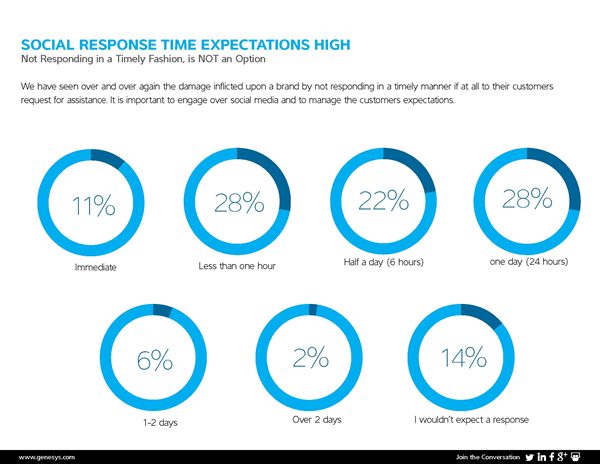
There is no debate about ownership, even if there is
The debate on the ownership of social customer service must end. In practice it is still a widely held debate (is it the contact center or customer service department, is it comms, is it marketing,…) and given the increasing realization regarding the importance of everyone in the customer service equation it will continue to rage for quite some time. However, for service-intensive organizations customer care is too important and complex to put it in marketing, comms or a dedicated team. If you run a smaller business with little social customer care or a smaller customer base the picture can be completely different of course but in larger organizations dealing with more complex questions and facing more interaction and information channels and sources the contact center becomes essential.
No room for disconnects anymore
Again, it isn’t that much about the exact operational structure. And context matters. Each organization is different so there is no ‘best solution’. It’s not even about ownership as no one owns the customer but the customer himself. But it is about responsibility and there is no room for disconnected teams, channels, information sources and experiences.
If your contact center is properly organized and you have many enquiries to handle across various channels and stages with lots of information sources and formats then your contact center is probably the best place to gradually put social care and align metrics and KPIs. If it’s not possible, make sure that the customer doesn’t feel it as he has no patience.
Social customer service on the rise: an omni-channel approach to care and context
As said there is no single best way to organize the way you use social media for customer service, even if we see a clear evolution whereby the contact center is playing a more central role in general. The ways you organize your social customer service depend on industry and obviously how customers use social today.
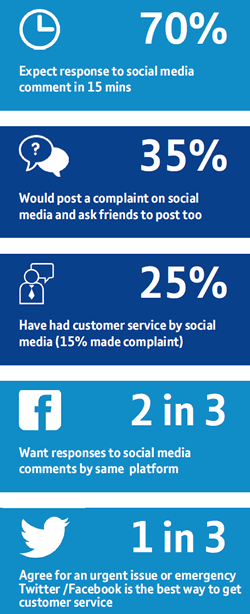
The latest edition of research by BT and Avaya, called The Autonomous Customer, provides insights into how customers are using social media for customer service. It’s clear that social customer service is certainly important in the industries where we see consumers and customers embracing social for support more than in others.
Overall one in four consumers are choosing social for customer service. Moreover, consumers want more customer service through social media and less marketing. It’s not a surprise that contact centers are looking deeper into social and several organizations rethink the ways they conduct social customer care. Web chat (the fastest grower) aside, social media customer service was the fastest growing category in the past five years the study found, with 25% of consumers having accessed customer service through social media and 15% stating they had made a complaint through social.
The public nature of complaints on social media is one of the reasons why many still think social customer service should be approached ‘differently’ because of the relationship with reputation and potentially bad cases being picked up by other social media users and media, for instance. It is still a primary reason why some contact centers and organizations overall are still ‘scared’ about social customer service and even social as such.
We can’t but repeat what we’ve been saying for years now: if customers want to complain, they will, so it’s best that you’re there when they do instead of closing your eyes and, when prioritizing your customer service channels you need to take that into account in a holistic way, understanding the reality of your customers and industry.
Social media monitoring is closely related with social care, yet this doesn’t mean it can’t be done within a contact center environment where sentiment analysis and an omni-channel approach to contextually understanding – and acting upon – information entering the front office and back office, as well as information being shared about the brand – in a service and experience context – are becoming crucial anyway. It’s one of the reasons why we see acquisitions happening in the market, the larger players offer such possibilities and there are new entrants who focus on analysis of information, regardless of channels and information formats (in the case of social unstructured data).
The challenges of channels when the customer is channel-agnostic
Customers don’t think in terms of channels. They use social media just as they use email, the phone or any other channel to get served. Ignoring comments and service requests as is still done according to the research, is not the way to go. Especially as two in three consumers who direct a comment at a brand expect a response through the same platform.
The latter has important consequences on how you organize social care, not from an organizational perspective but from an integrated perspective: the information about the customer (case) should be available to the agent, to anyone in a potential separate social team and to the customers themselves when possible and needed.
Seeing social media as a way to just reduce pressure on the customer service staff and building an intermediary step by sending customers to a form or other channel for a more private conversation is not what customers want: they want to be answered through the same platform in most cases as wanted.
Context matters: why and when customers pick social customer service
This brings us also to the question of the context in which people turn to social platforms and channels for service. It can be a mix of things of course. If a business is well-known for excellent social customer service and/or is active in a market where social and digital are inherent to the core business (think about how web hosting companies were early adopters of web chat or how companies offering social media platforms obviously need to prove they understand the usage and optimization of the very channels they are built for).
However, in general we see people mainly turn to social channels when they are already highly unhappy and feel the need to voice this and, last but not least, in case of urgencies.
Social customer service is often used as a last resort or as a means to solve an issues that needs to be solved right away, certainly in situations where it’s the easiest to use (think about a customer with an urgent issue in a context where it’s harder to get support, for instance in an airport when only having a smartphone – again context).
The BT and Avaya research also shows it: one in three consumers said that social channels are the best ways to contact organizations in urgent situations. No wonder that the large majority (70%) expects a response to social media comments in 15 minutes. And here is the thing: without a holistic approach whereby information is easily and rapidly accessible it is simply impossible to achieve this.
Social customer service: not just about Twitter
When we think about social customer service we often think about Twitter but it’s certainly not the only channel. In fact, it’s surprising to see the high percentages of people who stated they would post a Facebook customer service message to an organization. In most European countries and the US the numbers are still “relatively” modest but just look at those percentages in India (88%), the UAE (87%) and Indonesia (80%). But even the 40% we see in Germany is still worth taking into account.
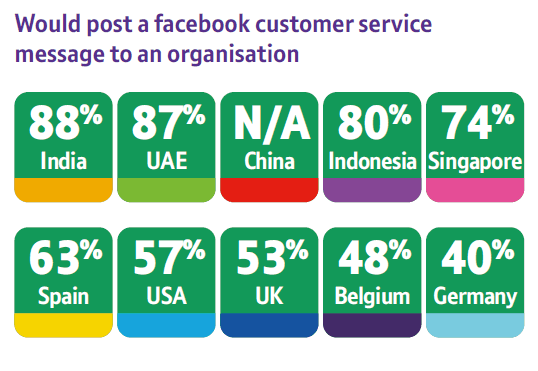
Obviously it also again depends on the type of business, industry etc. and there is a difference between intent and reality but there are ample organizations where customers indeed use Facebook for customer service, sometimes just questions and not seldom complaints, certainly in a few traditional verticals – often services – where customer service overall is typically not loved too much. You need to monitor those interactions.
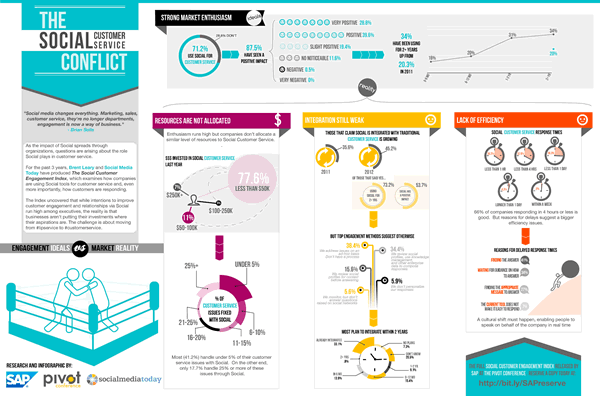
Dimension Data’s 2015 Global Contact Centre Benchmarking Report, © Dimension Data 2009-2015.

